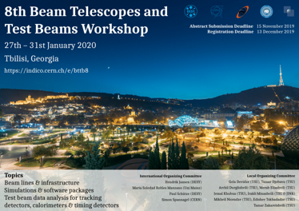Speaker
Description
The Mu3e experiment will search for the charged lepton flavor violating decay of an anti-muon into two positrons and an electron. Up to $10^9$ anti-muons per second will be stopped on a target, allowing to reach a sensitivity of $10^{-16}$. The reconstruction of the trajectories of the low-momentum decay particles requires an ultra-thin pixel detector with excellent momentum, vertex and time resolution.
The baseline for this project is the high-voltage monolithic active pixel sensor (HV-MAPS). The sensors are thinned down to 50 um and connected to high density interconnects via SpTAB bonds, creating an ultra-thin tracking layer with a material budget of 0.115 % radiation lengths. The triggerless readout of sensors, in combination with the on-chip zero suppression, allows operation at high rates.
In the context of pixel sensor R&D, test beam campaigns are used to investigate efficiency, time resolution, and noise. For efficient test beams at various facilities, a thin tracking telescope based on HV-MAPS is developed. It allows the implementation of new prototype generations of MuPix and ATLASPix with minimal effort. The compact configuration of the telescope comprises three reference layers of the latest large scale HV-MAPS prototype, a device under test, and scintillating tiles for additional precise time information.
The talk introduces the MuPix-telescope and sketches its performance. A selection of highlights from test beam campaigns is presented, and an outlook for the telescope's future is discussed.
